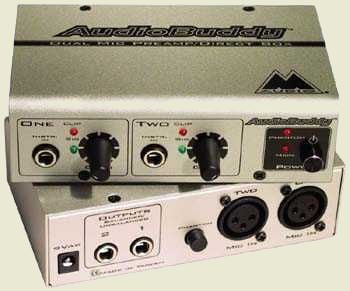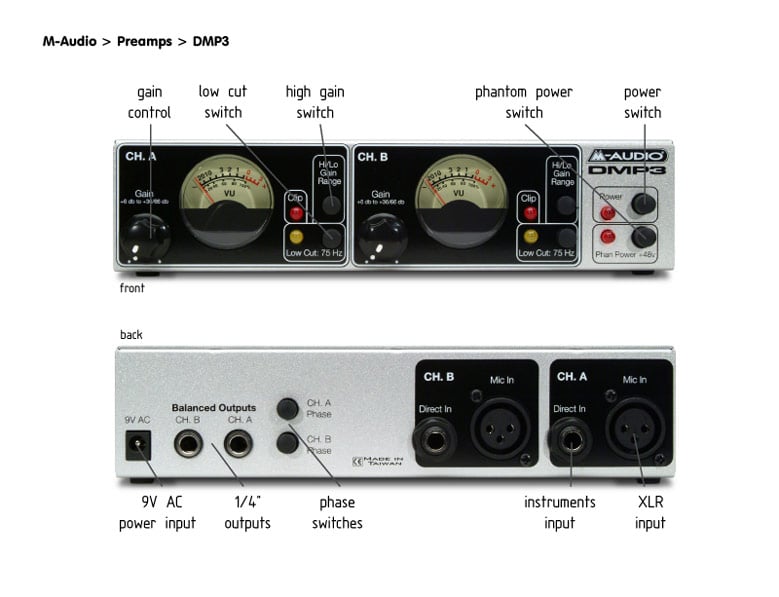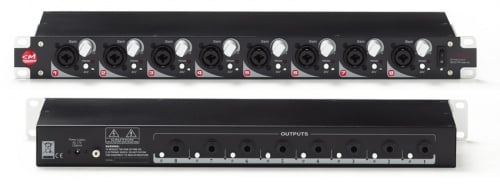M Audio Dmp3 Mic Preamp Review
Contents |
Basic Info
Review by: Ivan Milenkovic.
Brand: M-Audio.
Model: DMP3.
Price: ~160$. (3.4.2009 reference)
Manufacturer Specs
Frequency Response: 20Hz – 80kHz, +/-0.5dB @ max gain.
SNR: -120dB, A-weighted, 20Hz to 20kHz.
THD+N: 0.00035% (-109dB), 20Hz to 20kHz, @ +13.6dBu input.
Max Input: +14.6dBu.
Max Output: +27.5dBu.
Input Impedance: 3k Ohms balanced.
EIN: -128dBm @ 600 Ohms, max gain.
Gain Range:
- 13.5dB to 46.5dB, low gain range.
- 39.5dB to 72.5dB, high gain range.
Low-cut Filter: -3dB @ 72Hz. (18dB/Octave)
Reason for Purchasing
I needed a device that will enable me to amplify signal from microphones & instruments, so I can feed it into 1212m audio system. 1212m has no preamps on its own, and it has 2 TRS 1/4 jack inputs. This device is a 2 channel preamp, so I can use both channels in separately, and feed each of the channels to the card's inputs. I've used Behringer MIC800 preamp before this, here's the picture:

which is a 1 channel preamp. This solution was not good at all for me, cause MIC800 has a lot of noise and although it tends to emulate valve mic preamps, it doesn't do a very good job at this. Signal was bassy and muddy when valve modeling was added, and even without any modeling it is weak and full of hiss. But at such a low price (~50$) this was expected in some way.

which is around 80$. But knowing the quality I got from a 50$ Behringer 1 channel mic preamp, I was guessing that 2 channel preamp for 80$ couldn't be that much of an upgrade. I chose DMP3, and it wasn't a mistake at all - this preamp is worth it.
Device Design
I got this device in a very interesting package. The device was in a big box, vacuumed down to a piece of cardboard, so it doesn't move withing the box. This solution is pretty good to me, although it took some time to take of the plastic wrap. One knob took off, and stayed within the plastic wrapper when I was unpacking, but I managed to put it back in the position easily. Knobs are not glued to the metal part of the pot, and I don't consider this a flaw.
The DMP3 is very easy to use, and although you get the manual, you can use it straight from the box, as it has very little knobs, and they are clearly labeled. Manual can be useful because of the exact specs, so you know exactly how preamp behaves within the system (check out manufacturer specs at the beginning for that detailed info)
In the front front you have separated controls for the 2 channels, Gain, Hi/Lo gain range, Low Cut 75Hz, Clip diode, and VU meters. Also there are Power and Phantom Power switches to the right with LED diodes.
In the back of the device there are 2 pairs of Hi-Z & XLR inputs, a pair of phase switches, pair or TRS 1/4 jack outputs and 9V AC input. Adapter is supplied with the device. Mind that the device uses AC current instead of DC current, so you have to use the adapter supplied.

The unit seems very sturdy, and it is made out of metal sheets, instead of plastic. Nice and heavy as well. I wouldn't bump the preamp too much tho, because of the sensitive VU meters, but looks and feels pretty reliable and I think stacking other devices on top of it, wouldn't harm the device.
This device is not getting hot at all after 8-9 hours or usage, so it is safe to keep other gear/temperature sensitive stuff around it.
The VU meters are a nice touch, but I haven't matched them with the input of my card, so the needle don't move that much, although I get pretty big signal on the card inputs.
One thing that could be a problem with this device, is that it doesn't fit the height of one rack space. It fits the width of half space, but not the height, so you have to use 2 rack spaces if you are planning of putting it into your rack. I think it is designed mainly as a desktop unit, and I keep it that way for now, so I have no problem with this, but in studios where you keep all the equipment in racks and have limited rack/desktop space it could be a potential problem.
Sound Quality
As I said I used this preamp along side 1212m card, and these two matched very nicely. I use an electric guitar on channel 1, and dynamic microphone on channel two. I've found the electric guitar needs a lot less power, so I use Lo Gain switch (13.5dB to 46.5dB gain range), and adjust the gain knob at 9 o'clock. On the microphone side, I need a lot more gain, so I use Hi gain switch (39.5dB to 72.5dB gain range) and knob at 12 o'clock. Still a half circle left, and the signal can be pretty hot, so I think this amp is doing a great job at amplifying the signals that are fed into it.
This is a solid state mic preamp, which means it doesn't add any warmth that a tube mic preamp would add. It is meant to be a completely transparent with it's 20Hz-80kHz frequency response. I haven't used any high end mic preamps so I can compare, but I'm more than satisfied with this device. It really has a crystal clear sound, and sounds very natural to me, no phasing, shifting of the signal, it sounds really really smooth and natural, both with instrument & microphone. Since it is solid state, it has a bit of high end sizzle but I don't consider it a bad thing, I actually like the wide response. This sizzle doesn't sound harsh at all, it really brings up all those transients naturally, and with some shelving/mixing you can make it sound whatever you like. The main point is that this preamp has great sound range response, and all the frequencies are there, and amplified with a considerable amount of loudness (+66dB) and without ANY noise on the settings that I use.
I have gotten some noise from this device on maximum settings, but this noise is very "smooth" and in the background. It doesn't interfere with the signal even on max settings, so I would say it is a VERY quiet preamp. Also the unit can be extremely loud, so I don't think maximum settings are something that a lot of people will use in their setup.
Devices In A Similar Price Range

Behringer T1953 Tube Ultragain (4 channel mic preamp) ~150$

SM Pro Audio PR8E (8-Channel Microphone Preamp) ~170$

ART TPS II (2 channel mic preamp) ~180$
Overall Impression
This preamp is for serious musician on a tight budget that wants to either upgrade current mic preamps or add additional pair of amplified channels to his audio system inputs. It doesn't have any compression, or EQ, only what is needed to get the job done. It can be used in semi-pro situations no problem. For a great price it brings a great deal of signal freshness to your audio setup, so I recommend it to anyone who wants an extremely clean, extremely noise free 2 channel mic preamp that doesn't add any color, and doesn't stand in a way of you and making music.
--Sensible Jones 12:51, 7 April 2009 (CEST)






